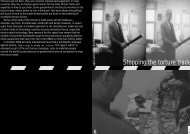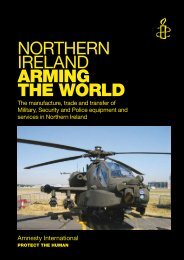CROWD CONTROL TECHNOLOGIES - Omega Research Foundation
CROWD CONTROL TECHNOLOGIES - Omega Research Foundation
CROWD CONTROL TECHNOLOGIES - Omega Research Foundation
You also want an ePaper? Increase the reach of your titles
YUMPU automatically turns print PDFs into web optimized ePapers that Google loves.
cultures. This process is perhaps most pronounced in the United States where for the last twenty years<br />
Congress has encouraged the US military to supply new weapons and training to the civilian police<br />
forces. This has institutionalised Special Weapons and Tactics (SWAT) squads in almost every state.<br />
263 A new study by the US CATO Institute warns that the mindset of the soldier is simply not<br />
appropriate for the civilian police officer. Police officers confront not an enemy but individuals who are<br />
protected by the Bill of Rights. 264<br />
According to the Cato Institute study, since such armaments are only necessary in extraordinary<br />
circumstances, the deployment of such units should therefore be infrequent rather than routine.<br />
Instead, the CATO Institute reports that SWAT Teams )are everywhere, doing everything... Police are<br />
now patrolling mundane non-emergency situations, serve warrants etc in full battledress. Confusing the<br />
police functions with the military function can lead to dangerous and unintended consequences - such<br />
as unnecessary shootings and killings.( 265 Soldiers expect a war of attrition which can often be<br />
indiscriminate. Police officers however, work within the premises of a legal framework predicated on<br />
minimum force and discriminate control rather than free-fire zones. Unfortunately, once this process of<br />
militarisation of the police begins, it is quickly normalised and justified in new budget allocation<br />
proposals and institutionalised standard working procedures. 266 Thus by 1994, the Department of<br />
Justice and the Department of Defense had signed a memorandum of understanding which enabled<br />
the military to transfer technology to state and local police forces giving civilian police high-tech military<br />
hardware previously only issued during wartime. These technologies have included some of the crowd<br />
control weapons which are the subject of this present study. 267 Any move towards adopting these alien<br />
principles in Europe will undermine agreements made under the Amsterdam Treaty in 1997, to create<br />
zones of freedom, security and justice within the European Union. 268<br />
5.1 Chemical Irritant Weapons can facilitate human rights abuses in several different ways including<br />
the infliction of street punishment, an activity explicitly prohibited in most guidelines. There is a long<br />
history of such practices, in the US for example. 269 More recently, the UN Committee Against Torture<br />
criticised the USA about the number of cases of police ill-treatment of civilians. Evidence submitted to<br />
the UN Committee by Amnesty International covered the misuse of pepper-gas spray. On the 4 th May<br />
2000 the San Francisco Federal Appeals Court ruled that )Oleoresin Capsicum (OC) spray (also known<br />
as )pepper spray() may in some circumstances constitute an unconstitutionally and unreasonable use<br />
of force. ) 270 This ruling stemmed from cases of officers deliberately breaching guidelines by using OC<br />
(pepper-gas) to inflict punishment. Video evidence showed California police deputies pulling back the<br />
heads of environmental protestors, opening their eyelids and swabbing the burning liquid directly onto<br />
their eyeballs - an action described by Amnesty International as tantamount to torture. 271 The US<br />
police had subsequently continued to use this strategy as evidenced by the treatment of non-violent<br />
protestors during the WTO demonstrations in Seattle, November 1999 (some non-violent protestors<br />
who refused to leave Police buses on arrival at Seattle detention centers have alleged that police<br />
officers pulled back their eyelids and put pepper spray or gel into their eyes, nose and mouth).<br />
Amnesty International has stated that the San Francisco Federal ruling )should clearly signal to<br />
law enforcement officers that it is no longer acceptable to use pepper spray in such a calculated<br />
and deliberate way to inflict pain as a way of subduing demonstrators who pose no threat(.<br />
Amnesty further stated that )we now hope it will influence police practices not only in California, but in<br />
the USA as a whole(. Europe is not immune from such abusive practices. Evidence has emerged in<br />
the UK of police abusing CS sprays in breach guidelines to make the targets more compliant. More<br />
seriously, in Austria the UN Committee on the Prevention of Torture found a recent case of pepper gas<br />
being used by the Austrian police to carry out a racial attack. 272 It is reasonable to suggest that<br />
Amnesty Internationals advice should also be adopted by any European Union member that deploys<br />
any chemical irritant weapons.<br />
There is a risk when lethal weapons are used in used in conjunction with chemical irritants (and<br />
other crowd control technologies) that escape is inhibited or prevented leading to excessive exposure.<br />
This is particularly true when )carpet gas bombing( tactics are used by security forces. These should<br />
always be seen as an abuse because there is no way of distinguishing targets from innocents. The<br />
excessive use of chemical irritants is widespread as is their use in conjunction with more lethal<br />
xxxv




